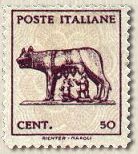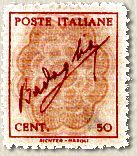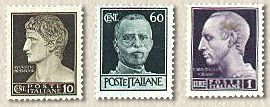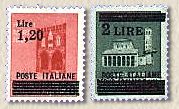
The lack of the stamps necessary to restore postal service forced the government to require the printing by private typography of a new, simple sketch depicting the "Lupa Capitolina". When Rome became free, the constitutional government could once again use the machinery of the State Printing Institute although it had been reduced because a large part had been transferred to Novara by the fascists, anticipating a retreat. The designs of the "imperial" set were changed by removing the emblems of the "fascio littorio". Furthermore, because of the lack of materials, all the left-over stamps were used and, consequently, the stamps overprinted "P.M." (Military Post) and two R.S.I. values, after having been overprinted. After Northern Italy's liberation, the Novara section was entrusted to print stamps to meet new needs.
Now, here it is a brief description of the issues.

January 1944 - issue of the Italian Government moved to Bari: one 50c value named "Lupa Capitolina". Offset printing in sheets consisting of 150 pieces (10x15) by the Richter e C. firm in Naples, not gummed, with hexagonal watermark. This stamp was used almost exclusively in Southern Italy.
May 1944 - issue of a new 50c value which reproduced again the "Lupa Capitolina" without watermark and in sheets consisting of 168 pieces (12x14). This stamp, after the liberation, was distributed also in Central-Northern Italy.

After the restoration of the Badoglio government in the South, the Richter e C. firm in Naples received the assignment to produce a stamp similar to the previous with, in the middle, the "signature of the chief of the Government" in the place later reserved for the "Lupa Capitolina". The production of this stamp was abandoned because it was considered too "personalized". (It seems that same Victor Emmanuel III put a veto on it.) Anyway, some proofs came into the market, printed in sheets consisting of 25 pieces, without watermark or with a vertical hexagonal watermark, perforated 11¼ or imperforate, gummed, in 4 colors: violet and light lilac-gray; turquoise and light sky-blue; black and gray; brick rose and light salmon. The only value: 50c.
The two issues of the "Lupa Capitolina" are mistakenly listed in the period of the "Lieutenancy" although they actually belong to the Reign of Victor Emmanuel III.


November 1944 / February 1945 - issue of four values (30c, 50c, 60c, 1 Lira) of the "Imperial" set type without fasces. Rotogravure process by I.P.S. - O.C.V. in Rome, 'crown' watermark, perforated; March 14, 1945, new 2.50 Lira value overprinted on the 1.75 Lira value of the "Imperial" set. Typographic black overprint by I.P.S. - O.C.V. in Rome, 'crown' watermark, perforated 14.
May 1945 - issue of three values (10c, 60c, 1 Lira) of the "Imperial" set type without fasces, no watermark. Rotogravure process by I.P.S. - O.C.V. in Rome.

May 2, 1945 - new value overprinted on stamps of the Social Italian Republic of the first "Destroyed Monuments" set: 1,20 Lira on 20c; 2 Lira on 25c. Typographic black overprint by I.P.S. - O.C.V. in Rome, 'crown' watermark, perforated 14.
In time the lack of material and paper values required the use of stamps of the capitulated fascist regime to meet the needs of increasing postal fees that brought the cost of an ordinary letter to 2 Lira.
May 1945 - issue of three values (15c, 35c, 1 Lira) of the "Imperial" set type with fasces. Rotogravure process by I.P.S. - O.C.V. of the Novara section. No watermark, perforated 14. The printing of such values was ordered by the Post Office Department in Rome to face the postal needs within recently set free Northern Italy. It's plain once again the emergency requirement: they had to use rollers on which the fasces still appeared.

August 1945 / March 1946 - issue of seven values (10c, 20c, 50c, 60c, 1 Lira, 2 Lira, 10 Lira) of the "imperial" set type, without fasces. Rotogravure process by the Novara section of I.P.S. - O.C.V. No watermark, perforated 14. The use of the Novara section again became essential for the production and distribution of stamps because the conditions of the lines of communication were still precarious because of damage caused by the war. Anyway, they managed the removal of the "fasci littori". Furthermore, it's important to point out that the Novara issues lacked stamps depicting the King's effigy, which didn't happen in the Roman issues. It is probably true that, having been prohibited to reproduce the King's effigy on Social Italian Republic stamps, we can suurmise that the respective rollers had been made useless.
May / November 1945 - issue of seven values (20c, 60c, 1 Lira, 1.25 Lira, 2 Lira, 5 Lira, 10 Lira of the "imperial" set type without fasces. Rotogravure process by I.P.S. - O.C.V. in Rome. Watermark winged wheel, first type, perforated 14. With this set, for the first time the crown watermark used for the Kingdom stamps was abandoned, and a new watermark was introduced that, because of its design, is named "ruota alata" (winged wheel).
All the above-mentioned stamps were valid on correspondence until July 18, 1946, with the exception of the 1.20 Lira value of August, 1945, which was valid until December 31, 1948.
It the lieutenancy period belong: one 5 Lira express stamp, issued in August, 1945, "Italia turrita"; two values of pneumatic post (60c, 1.40 Lira) of the 1933 type with royal coat-of-arms but without "fasci littori" (Dante and Galileo) issued on October 22, 1945; two values for authorized delivery: 40c and 10c, issued in May, 1945, and one 40c value, issued in August 1945.
The chaotic postwar situation is largely documented. Because of the lack of paper materials for stamp production, and the difficulties in supplying the stamps there were, mail was franked with revenue stamps, postage-due stamps, and parcel stamps, and also "late" use of Kingdom and Republic of Salò stamps.
 |
 |
|
 |
 |